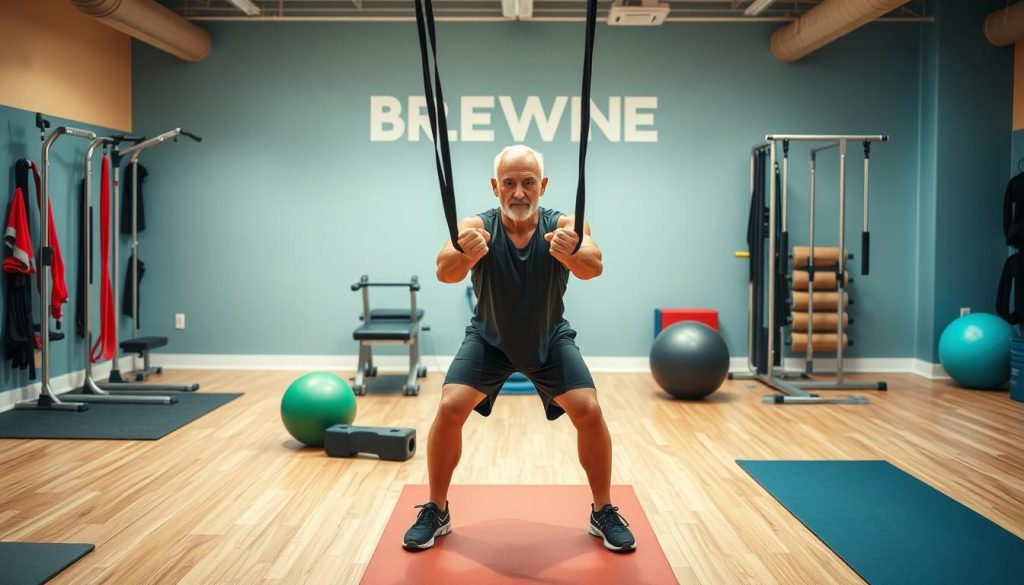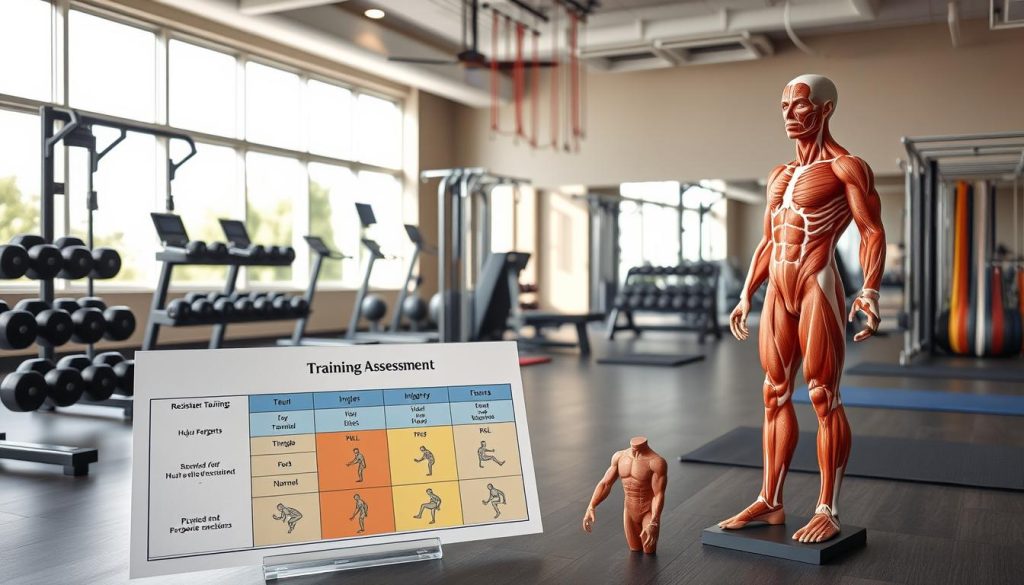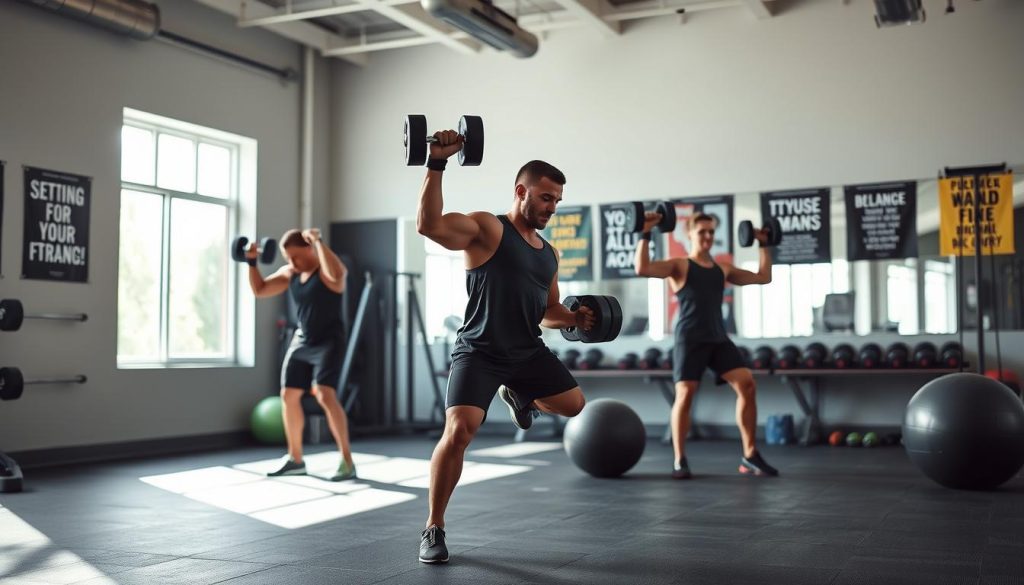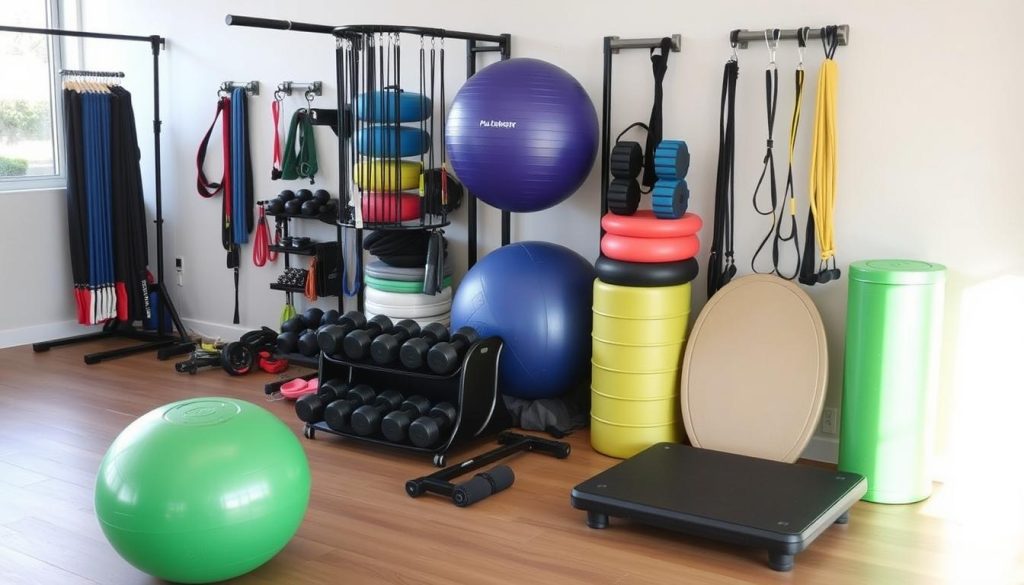Athletes and experts at Riverside Sports Therapy are changing how we recover from injuries. They use strength training in a smart way. This method helps get back to physical health and avoid future problems.
Today, sports medicine sees strength training as key, not just for fixing injuries. It’s a full plan to fix muscle weakness, make joints stable, and speed up healing.
Strength training helps patients get their muscles strong again. It also improves how nerves and muscles work together. Riverside Sports Therapy creates custom plans to help patients heal and perform better.
Key Takeaways
- Strength training speeds up injury recovery
- Specific exercises build muscle function
- Rehab goes beyond old ways
- Custom plans boost healing chances
- It also helps the nervous system recover fully
Understanding the Science Behind Strength Training for Recovery
Strength training is key in helping injuries heal. It’s not just about building muscle. It’s about using science to fix and restore the body.
Strength training sparks amazing healing responses in the body. To understand how it helps, we need to look at three main scientific ways:
Muscle Fiber Adaptation During Recovery
Muscle fibers change a lot when we’re recovering. When we do strength exercises, our muscles:
- Get better at fixing themselves
- Make more proteins
- Work more efficiently
Neurological Benefits of Resistance Training
Strength training also helps our nerves a lot. It:
- Fixes how nerves talk to muscles
- Makes our movements more precise
- Helps us feel where our body is
“Strength training is not just about rebuilding muscle, but rewiring the nervous system’s communication pathways.” – Dr. Sarah Reynolds, Sports Rehabilitation Specialist
Hormonal Response to Strength Exercise
| Hormone | Recovery Impact | Production Increase |
| Growth Hormone | Tissue Regeneration | 25-40% |
| Testosterone | Muscle Repair | 15-30% |
| Cortisol | Inflammation Management | 10-20% |
These hormonal changes really speed up recovery. They show how strength training and healing are closely linked.
The Role of Strength Training in Injury Recovery
Strength training is key in injury recovery. It offers a full approach to healing, beyond just getting better. Patients see faster recovery and better function with strength training.

-
- Restoring muscle balance and symmetry
- Improving joint stability and mobility
- Enhancing overall functional capacity
- Preventing muscle atrophy during recovery
“Targeted strength training can transform rehabilitation from passive treatment to active recovery.” – Sports Medicine Research Institute
Personalized strength training is vital for injury recovery. Each program must fit the injury, patient’s health, and recovery stage.
Recovery Stage Strength Training Focus Primary Objectives Initial Recovery Low-intensity exercises Maintain muscle activation Intermediate Recovery Progressive resistance training Rebuild muscle strength Advanced Recovery Functional movement patterns Restore full range of motion Integrating strength training in rehabilitation requires careful assessment and professional guidance to ensure safe and effective recovery.
Common Injuries That Benefit from Strength Training
Strength training is a key part of getting better after an injury. It helps people move better and feel stronger. Different injuries need different strength training plans to heal well.

People who play sports, work hard, or have long-term health issues can use strength training to heal faster. The right plan can make recovery a positive experience.
Sports-Related Injuries
Sports injuries need special care. Strength training helps with common injuries like:
- ACL (Anterior Cruciate Ligament) reconstruction
- Rotator cuff tears
- Ankle and knee ligament injuries
- Shoulder impingement syndrome
Workplace Injuries
Jobs can cause injuries. Strength training helps with injuries like:
- Lower back strain
- Repetitive stress injuries
- Carpal tunnel syndrome
- Neck and shoulder tension
Chronic Conditions
People with long-term health issues can also benefit from strength training. It helps manage symptoms and improve life for conditions such as:
- Arthritis
- Fibromyalgia
- Osteoporosis
- Chronic pain syndromes
“Recovery is not just about healing, but about becoming stronger than before.” – Sports Rehabilitation Expert
| Injury Type | Strength Training Benefits | Recovery Potencial |
| Sports Injuries | Muscle stabilization | High |
| Workplace Injuries | Functional movement restoration | Moderate to High |
| Chronic Conditions | Pain management | Moderate |
Each injury needs a special strength training plan for safe and effective recovery.
Assessing Readiness for Strength Training Post-Injury

Knowing when to start strength training after an injury is key. Doctors look at many things to make sure it’s safe and works well. They check if you’re ready to start.
“Successful rehabilitation begins with understanding your body’s unique healing process” – Dr. Sarah Thompson, Sports Medicine Specialist
How ready you are for strength training depends on careful checks. Important things to look at include:
- Pain severity and frequency
- Range of motion measurements
- Tissue healing stages
- Biomechanical movement patterns
Doctors use detailed tests to see if you’re ready. These tests help avoid injuries and make plans just for you.
| Assessment Criteria | Evaluation Method | Recovery Indicator |
| Pain Levels | Visual Analog Scale | Consistent Low Pain |
| Joint Mobility | Goniometric Measurements | 90% Normal Range |
| Muscle Strength | Dynamometer Testing | Symmetrical Strength |
Professional guidance ensures a safe and strategic approach to rehabilitation strength training.
Building a Progressive Recovery Program
Recovering from injuries with strength training needs a step-by-step plan. This plan helps rebuild your strength and confidence. It includes the best exercises for injury recovery, divided into three phases.

Creating a good strength training plan for injuries takes time and care. Each phase has its own goals. These goals help you recover safely and steadily.
Phase One: Initial Movement Patterns
The first phase is about getting back to basic movements. Its main goals are:
- Reestablishing neuromuscular control
- Reducing pain and inflammation
- Improving joint mobility
“Recovery is not about perfection, but progression.” – Sports Rehabilitation Expert
Phase Two: Resistance Introduction
When you can move better, it’s time for light resistance training. This phase starts with:
- Bodyweight exercises
- Resistance band work
- Light dumbbell movements
Phase Three: Advanced Strengthening
The last phase gets you ready for full strength. Exercises get tougher, focusing on movements you need for sports or work.
Consistent, mindful progression is key to successful injury recovery through strength training.
Essential Equipment for Rehabilitation Strength Training
Choosing the right equipment is key for strength training in rehab. The right tools help patients recover faster and safely. Knowing which equipment is best for healing is the first step.

-
- Resistance Bands: Versatile and low-impact, ideal for gentle muscle engagement
- Free Weights: Progressive resistance for controlled muscle rebuilding
- Medicine Balls: Dynamic movement training with controlled weight
- Stability Balls: Core strengthening and balance improvement
“The right equipment transforms rehabilitation from a challenge to an opportunity for healing.” – Sports Rehabilitation Expert
Choosing the right equipment depends on the patient’s needs. It’s important for patients to work with physical therapists. They help pick the best tools for their injury and stage of recovery.
Equipment Type Recovery Benefits Recommended Usage Resistance Bands Low Stress Muscle Activation Early Recovery Stages Free Weights Muscle Strength Rebuilding Mid-Recovery Phases Stability Equipment Balance Restoration Progressive Rehabilitation Getting professional advice is vital when using these tools in a rehab program. Each piece has its own benefits for muscle recovery and injury prevention.
Safe Training Techniques During Recovery
Strength training after injury needs a careful and precise approach. The recovery journey requires a method that protects healing muscles and builds physical strength. It’s important to know safe training techniques to avoid setbacks.

The rehabilitation process includes key components for effective and safe muscle development.
Proper Form and Alignment
Keeping the body in the right position during strength training is vital. It prevents strain and injury. Proper alignment means:
- Engaging core muscles consistently
- Maintaining neutral spine positioning
- Distributing weight evenly
- Avoiding compensatory movements
Breathing Mechanics
Breathing is key in strength training for recovery. Controlled breathing helps stabilize muscles and boosts performance.
“Breath is the bridge between muscular tension and relaxation” – Rehabilitation Specialists
Movement Control
Slow, deliberate movements are key during recovery strength training. These controlled actions improve:
- Muscle awareness
- Proprioceptive skills
- Neuromuscular coordination
- Reduced injury risk
Precision trumps intensity during rehabilitation exercises. Focusing on quality movement patterns leads to safer, more effective recovery.
Monitoring Progress and Adjusting Training Intensity
Tracking progress is key in a good strength training plan for injuries. The healing journey needs careful checks and smart tweaks for the best results.

Good monitoring uses many ways to see how strength training helps with recovery. Experts say it’s important to track progress well.
- Strength testing at regular intervals
- Range of motion measurements
- Functional movement assessments
- Pain level evaluation
Technology is big in tracking recovery today. Wearables and apps give detailed info on how well someone is healing.
| Assessment Method | Frequency | Purpose |
| Strength Tests | Bi-weekly | Measure muscle recovery and development |
| Range of Motion | Weekly | Track flexibility improvements |
| Pain Evaluation | Daily/Session | Monitor recovery comfort levels |
“Recovery is not a linear process. Adaptive programming is key to successful rehabilitation.” – Sports Medicine Research Institute
Adjusting plans is very important in strength training for injuries. Athletes and patients need to work with health experts to change the intensity based on how they’re healing.
Integrating Strength Training with Physical Therapy
Strength training and physical therapy are a strong team in healing. Together, they offer a full plan for getting better and stronger.

To mix strength training with physical therapy, teamwork is key. Doctors and therapists must work together to create plans that help patients get better fast.
Coordination with Healthcare Providers
Good healing needs everyone on the same page. Important steps include:
- Regular meetings among medical teams
- Shared health records online
- Setting goals together for recovery
- Keeping track of how patients do
“Effective rehabilitation is a team sport, where each professional contributes unique expertise to the patient’s recovery journey.” – Dr. Rachel Thompson, Sports Medicine Specialist
Complementary Therapeutic Approaches
Putting strength training and physical therapy together makes a strong plan for healing. Other helpful methods might be:
- Manual therapy techniques
- Teaching muscles to work right
- Exercises that build strength
- Checking how well patients move
Strength training and physical therapy synergies for recovery are leading the way in healing. By using special skills and flexible methods, doctors and therapists can make recovery plans that really work.
Preventing Re-Injury Through Strength Development

Strength training is key in stopping future injuries. It fixes muscle weaknesses and builds a strong body. This helps athletes and people recovering from injuries stay safe long-term.
“Strength is not just about muscle size, but about creating a resilient body that can withstand physical challenges.” – Sports Rehabilitation Expert
Here are some ways to stop re-injury through strength training:
- Identifying and correcting muscle imbalances
- Improving joint stability and flexibility
- Developing a strong muscle support system
- Creating specific rehab plans
Strength training is vital for recovery. It helps by:
- Building muscle strength slowly
- Boosting how muscles and nerves work together
- Making you less likely to get hurt again
- Keeping you physically strong over time
| Injury Prevention Aspect | Strength Training Benefit |
| Muscle Stability | Increases joint protection mechanisms |
| Muscular Endurance | Reduces fatigue-related injury risks |
| Proprioception | Improves body awareness and control |
Regular strength training turns recovery into a lasting way to stay healthy.
Recovery Nutrition to Support Strength Training
Proper nutrition is key to speeding up injury recovery from strength training. The right foods can greatly improve healing and muscle repair.
Athletes and those recovering from injuries need special diets. Protein is very important because it helps fix damaged tissues.
“Nutrition is not just about eating – it’s about fueling recovery and rebuilding stronger than before.” – Sports Nutrition Expert
- Protein requirements increase during rehabilitation
- Balanced macronutrient intake supports muscle recovery
- Timing of nutrient consumption matters
When adding strength training to recovery, you need a good nutrition plan. Certain nutrients help a lot with muscle healing and recovery:
| Nutrient | Recovery Function | Recommended Sources |
| Protein | Muscle tissue repair | Lean meats, fish, eggs |
| Omega-3 Fatty Acids | Reduce inflammation | Salmon, chia seeds, walnuts |
| Vitamin D | Muscle strength support | Fortified dairy, sunlight exposure |
Getting a nutrition plan that fits you is very important for recovery. Talking to a sports nutritionist can help make a plan that meets your injury and recovery needs.
Mental Aspects of Training During Recovery
Strength training after injury is more than just physical work. The mental journey is key to a successful recovery. Building psychological strength can greatly affect how well you heal and recover from an injury.
Dealing with mental hurdles in strength training needs a smart plan. Athletes and patients must build strong mental tools to face the unique challenges of recovery.
Setting Realistic Goals
Setting goals that are within reach is essential for injury recovery. Having realistic goals keeps you focused and avoids feelings of letdown.
- Break down long-term recovery into small, manageable milestones
- Document progress through a recovery journal
- Celebrate incremental achievements
Maintaining Motivation
Keeping motivated during injury recovery can be tough. Using mental strategies can help keep your enthusiasm and dedication to rehab strong.
- Visual goal tracking
- Positive self-talk
- Regular consultation with rehabilitation specialists
“Your mind is your most powerful muscle in recovery.” – Dr. Sarah Reynolds, Sports Rehabilitation Specialist
Overcoming Recovery Plateaus
Recovery plateaus are common in strength training after injury. Understanding and getting through these periods takes patience and smart strategies.
- Recognize plateau as a normal part of recovery
- Modify training techniques
- Seek professional guidance when progress stalls
Mental resilience transforms physical rehabilitation from a challenge into an opportunity for growth and strength development.
Success Stories from Riverside Sports Therapy
Riverside Sports Therapy has changed many lives with new ways to recover from injuries. Our clients show how strength training can lead to amazing recoveries. They’ve seen real results from our methods.
“Strength training wasn’t just about healing my injury—it was about reclaiming my athletic ability.” – Sarah Martinez, Professional Volleyball Player
We’ve seen amazing recoveries from all kinds of injuries. Our strength training exercises have helped athletes, workers, and people with long-term conditions. They’ve gained strength and confidence back.
- Professional Athlete Rehabilitation
- Workplace Injury Recovery
- Chronic Condition Management
Our approach includes specific exercises to:
- Rebuild muscle strength
- Get movement back to normal
- Lower the chance of getting hurt again
Every success story shows our dedication to custom, science-backed rehab plans. Our clients have gone beyond what’s expected in recovery. They’ve overcome shoulder repairs and knee ligament fixes.
Riverside Sports Therapy is at the forefront of new rehab methods. We prove that smart strength training can be a key to recovering from injuries.
Conclusion
Strength training is a key part of getting better after an injury. It helps patients heal and get back to their normal lives. This method goes beyond just medical treatments.
Riverside Sports Therapy knows how important strength training is. They create special programs for each patient. Their team uses resistance training to help muscles heal and get stronger.
Recovery is a journey that needs the right help and effort. People recovering from injuries or chronic conditions can benefit from strength training. Riverside Sports Therapy offers safe and effective training to support your recovery.
Want to improve your recovery? Call Riverside Sports Therapy at (403) 283-7551. Learn how their strength training programs can help you regain strength and confidence. Start your healing journey today.
For more details, visit: https://www.riversidesportstherapy.com/2025/01/27/how-sports-therapy-helps-with-common-injuries/
For more details, visit: https://www.riversidesportstherapy.com/calgary-contact/
